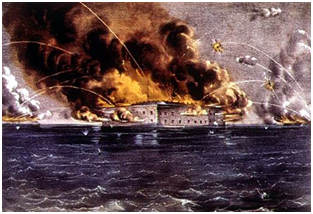By Zachary Klitzman
The American Revolutionary War has Lexington and Concord. The Spanish-American War has the Maine. World War II has Pearl Harbor. And the Civil War has Fort Sumter. Just like those other wars, the War Between the States was sparked by a single event, a single event that plunged America in armed conflict. Today, we celebrate the sesquicentennial of that fateful day, April 12, 1861.
Fort Sumter sat atop a man-made island in the mouth of Charleston Harbor, about four miles from downtown. It was designed for 650 men and 135 guns in three tiers, yet never reached its full capacity, and in fact was unfinished in 1860. The fort became a flashpoint when Union commander Robert Anderson secretly moved his force from indefensible Fort Moultrie to Fort Sumter six days after South Carolina seceded in December of 1860. (Anderson, along with General Winfield Scott and then-U.S. Senator Jefferson Davis, had been instrumental in founding the Soldiers’ Home in 1851. In fact, the building known today as President Lincoln’s Cottage was called the Anderson Cottage from 1889 until the National Trust took over stewardship in 2001.) The Confederate government sent several envoys requesting Anderson to relinquish the fort. Anderson refused, even though the Confederate general in charge of Charleston’s defenses was P.G.T Beauregard, a former West Point protégé of Anderson’s.
The Sumter crisis gave President Lincoln his first major challenge. In his inaugural he had promised that he would not start any war with the South, yet would “hold, occupy and possess” forts and garrisons controlled by the Federal government. The ensuing dilemma about whether or not to reinforce Sumter stressed the President. He often had sleepless nights, suffered from migraines and even fainted once trying to get out of bed. Looking back on the crisis in July 1861, Lincoln told his close friend and Illinois Senator Orville Browning – who visited the Cottage multiple times — that “of all the trials I have had since I came here, none begin to compare with those I had between the inauguration and the fall of Fort Sumter. They were so great that could I have anticipated them, I would not have believed it possible to survive them.”[1]
The conflict came to a climax in the wee hours of April 12. After one final ultimatum at 3:20 am was rejected by Anderson, a signaling shot erupted over Fort Sumter at 4:30am. Unlike the events that triggered the American Revolutionary War, Spanish-American War and World War II, there is more evidence documenting who opened the hostilities at Fort Sumter. After the signaling shot, Edmund Ruffin, a fire-eater secessionist from Virginia, had the honor of firing one of the first direct shots towards Sumter. Upset at the Upper South’s reluctance to secede, Ruffin had previously written that “The shedding of blood will serve to change many voters in the hesitating states, from the submission or procrastinating ranks, to the zealous for immediate secession.”[2] Although no blood was shed during the 34-hour attack (only a horse was killed), the stage was set for civil war.[3]
The firing on Fort Sumter enraged the North. The day after the surrender of the fort, Lincoln called for 75,000 volunteers to help squash the rebellion “too powerful to be suppressed by the ordinary course of judicial proceedings.”[4] The response was overwhelming; most states exceeded their quota of regiments, mustering 90,000 volunteers. As one Northern editorial wrote: “All squeamish sentimentality should be discarded, and bloody vengeance wreaked [sic] upon the heads of the contemptible traitors who have provoked it by their dastardly impertinence and rebellious acts.”[5] Though Lincoln did not react so furiously, he did tell a group of Southerners that his strategy had changed. Besides his previous goal “to hold, occupy and possess” federal property, his new aim was “to reposes, if I can, like places which had been seized before the Government was devolved upon me. And, in every event, I shall, to the extent of my ability, repel force by force.”[6]
It was, in effect, Lincoln’s declaration of war.
***
If you would like to see a cool visual depiction of the Battle of Fort Sumter, check out this neat animated map from the Civil War Trust .
And on Twitter, the Washington Post has a real-time thread of quotes from Anderson, Beauregard and other major players.
Pictured: Bombardment of Fort Sumter (1861), Currier & Ives.
Mr. Klitzman is the Executive Assistant at President Lincoln’s Cottage.
[1] Quoted in James McPherson Tried By War, New York: Penguin Book, 2008, 12.
[2] Quoted in James McPherson Battle Cry of Freedoom, New York: Oxford University Press, 1988, page 273.
[3] The first Union soldier to fire a shot back at the Confederates is also well-known: Captain Abner Doubleday, who often is incorrectly credited with the invention of baseball.
[4] Quoted in McPherson Battle Cry of Freedom, 274.
[5] Quoted in McPherson Battle Cry of Freedom, 275.
[6] Roy P. Basler, ed., The Collected Works of Lincoln, New Brunswick, NJ: Rutgers University Press, 1953-1955, IV:330.

